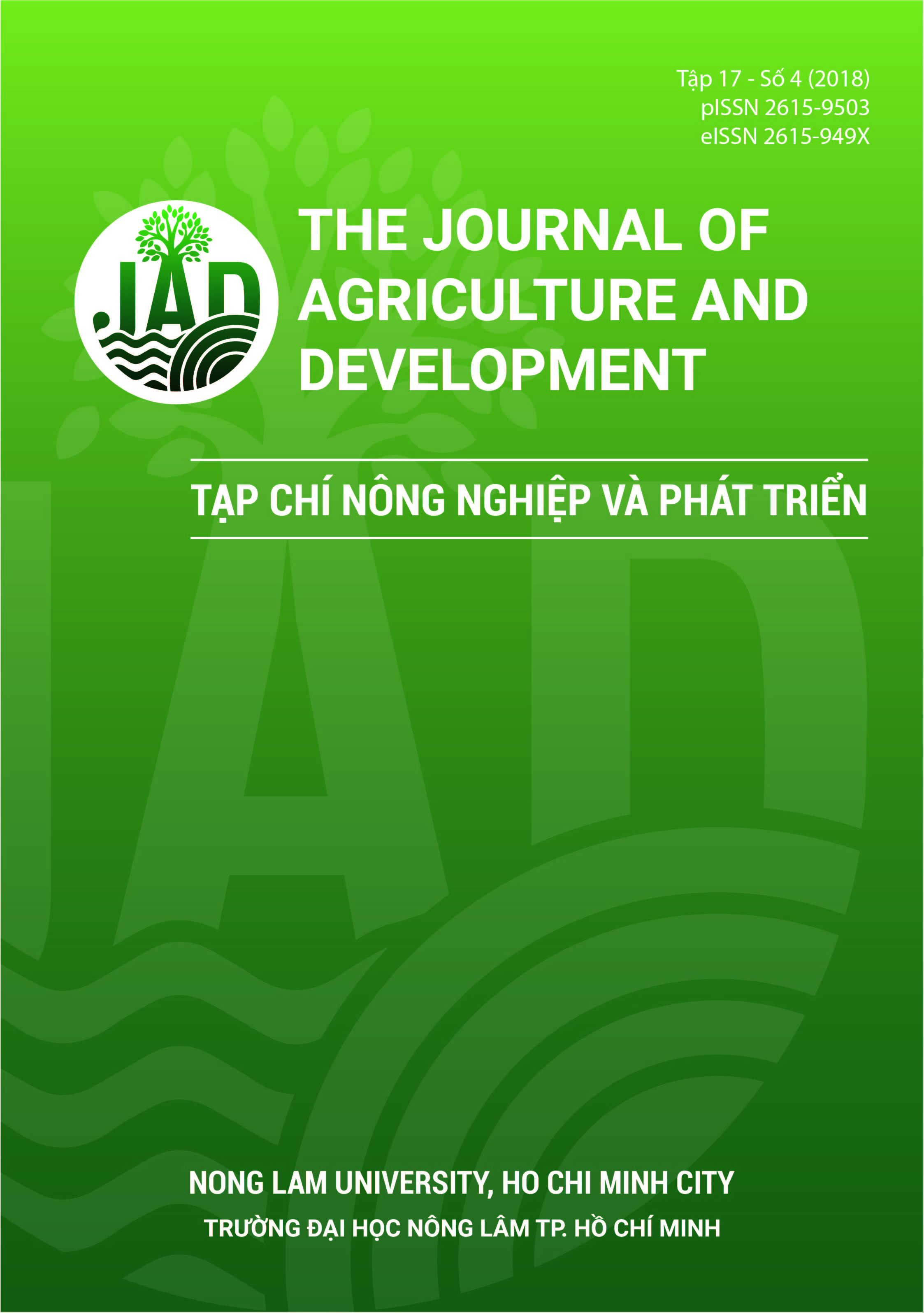Efficacy of florfenicol for control of mortality associated with Flavobacterium columnare in tilapia
Main Article Content
Abstract
The efficacy of florfenicol for control of mortality associated with Flavobacterium columnare was studied in tilapia. F. columnareT3-8/10 strain used for infection was tested for virulence by bath challenge to tilapia (body weight: BW 14 - 16 g) and antimicrobial sensitivity test. The results showed LD50 of this bacterial strain was 4.8 × 104CFU/mL and it was sensitive to florfenicol. Ex-periment for control mortality caused by the bacterium in tilapia (BW 18 – 20 g) was designed with four treatments including neg-ative control (unifected fish), positive control, NT10 and NT15 (infected with LD50). Just after infection, fish in positive control, NT10 and NT15 treatments were treated with florfenicol at doses of 0, 10 and 15 mg/kg BW/day for 10 days, respectively, by feed-ing fish with medicated feed. Mortality of fish in positive control treatment after 14 days of infection was 54.0 ± 5.47% and statisti-cally different in comparison with those in negative control, NT10 and NT15 treatments were 0.0, 3.0 ± 4.72 and 2.60 ± 2.51%, re-spectively (P < 0.05). Fish in NT10 and NT15 treatments were sampled for testing florfenicol residue in the flesh at day 1, 16, 20 and 24 after treatment. The results showed florfenicol residue levels in the flesh of sampled fish at all testing timepoints were sig-nificantly lower in comparision with the safe concentration lower than 1000 ppb regulated by the Ministry of Agriculture and Rural Development of Vietnam.
Article Details
References
Darwish, M. A., Bebak, J. A., & Schrader, K. K. (2012). Assessment of Aquaflor ®, copper sulphate and potassium permanganate for control of Aeromonas hydrophila and Flavobacterium columnare infection in sunshine bass. Morone chrysops female x Morone saxatilis male. Journal of Fish Diseases 35(9), 637-647. https://doi.org/10.1111/j.1365-2761.2012.01393.x
Edward, J. N. (2000). Fish disease diagnosis and treatment (2th ed., 272-273). Iowa, USA: Wiley and Blackwell.
Esteban S., Richard G. E., & John P. H. (2010). In vitro and in vivo efficacy of florfenicol for treatment of Francisella asiatica infection in tilapia. Antimicrobial Agents and Chemotherapy, 54(11), 4664-4670. https://doi.org/10.1128/AAC.00206-10
Figueido, H. C. P., Klesius, P. H., Arias, C. R., Evans, J., Shoemaker, C. A., & Pereira Jr, D. J. (2005). Isolation and characterization of strains of Flavobacterium columnare from Brazil. Journal of Fish Diseases 28(4), 199-204. https://doi.org/10.1111/j.1365-2761.2005.00616.x
Gaunt, P. S., Gao, D., Sun, F., & Endris, R. (2010). Efficacy of florfenicol for control of mortality caused by Flavobacterium columnare infection in Channel Cat fish. Journal of Aquatic Animal Health 22(2),115-122. https://doi.org/10.1577/H09-057.1
McGinnis, A., Gaunt, P., Santucci, T., Simmons, R., & Endris, R. (2003). In vitro evaluation of the susceptibility of Edwardsiella ictaluri, etiological agent of enteric septicemia in Channel Catfish, Ictalurus punctatus (Rafinesque), to florfenicol. Journal of Veterinary Diagnostic Investigation 15(6), 576-579. https://doi.org/10.1177/104063870301500612
NCCLS (National Committee for Clinical Laboratory Standard of Antimicrobial Susceptibility). (2001). Testing; Eleventh Information Supplement. Pennsylvania, USA: NCLS document M100-S11 NCCLS.
Patricia, S. G., Anissa. L. M., Timothy, D. S., Jean, C., & Peter, W. (2006). Field Efficacy of Florfenicol for Control of Mortality in Channel Catfish, Ictalurus punctatus (Rafinesque), Caused by Infection with Edwardsiella ictaluri. Journal of The World Aquaculture Society 37(1), 1-11. https://doi.org/10.1111/j.1749-7345.2006.00001.x
Panangala, V. S., Shoemaker, C. A., Van Santen, V. L., Dybvig, K., & Klesius, P. H. (2007). Multiplex-PCR for simultaneous detection of 3 bacterial fish pathogens, Flavobacterium columnare, Edwardsiella ictaluri, and Aeromonas hydrophila. Diseases of Aquatic Organism 74(3), 199-208. https://doi.org/10.3354/dao074199
Rahman, M. M., Ferdowsy, H., Kashem, M. A., & Foysal, M. J. (2010). Tail and fin rot disease of Indian major carp and climbing perch in Bangladesh. Journal of Biological Sciences 10(8), 800-804. https://doi.org/10.3923/jbs.2010.800.804
Reed, L.J., & Muench, H. (1938). A simple method of estimating fifty percent endpoints. The American Journal of Hygiene 27(3), 493-497. https://doi.org/10.1093/oxfordjournals.aje.a118408
Robert, M. D., Ronald, L. T., John, P. H., & Camus, A. C.& Camus, A. C. (1998). Columnaris disease: A bacterial infection caused by Flavobacterium columnare. Southern Regional Aquaculture Center Publication 479, 31-44.
Roiha, I. S., Samuelsen, O. B., & Harboe, T. (2011). Efficacy of florfenicol in the treatment of bacterial infections in halibut, Hippoglossus hippoglossus (L.), larvae. Journal of Fish Diseases 34(12), 927-930. https://doi.org/10.1111/j.1365-2761.2011.01307.x
Tu, D. T., Nguyen, T. T., & Nguyen, T. A. (2012). Study the aetiological agent causing white patch disease in catfish farm (Pangasianodon hypophthalmus) and therapy solution. Can Tho University Journal of Science 22c, 136-145.








